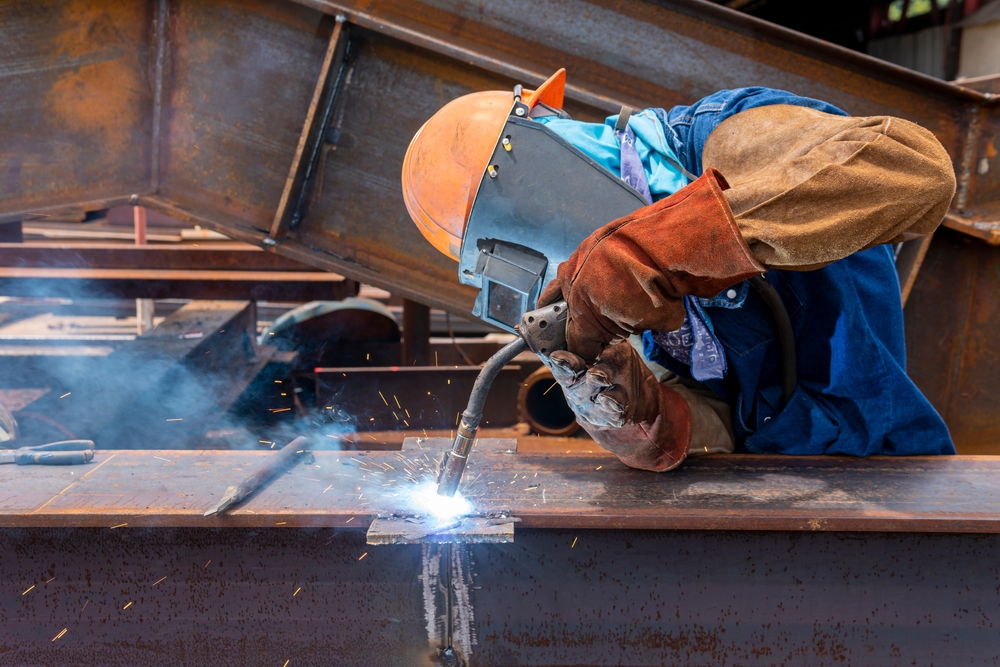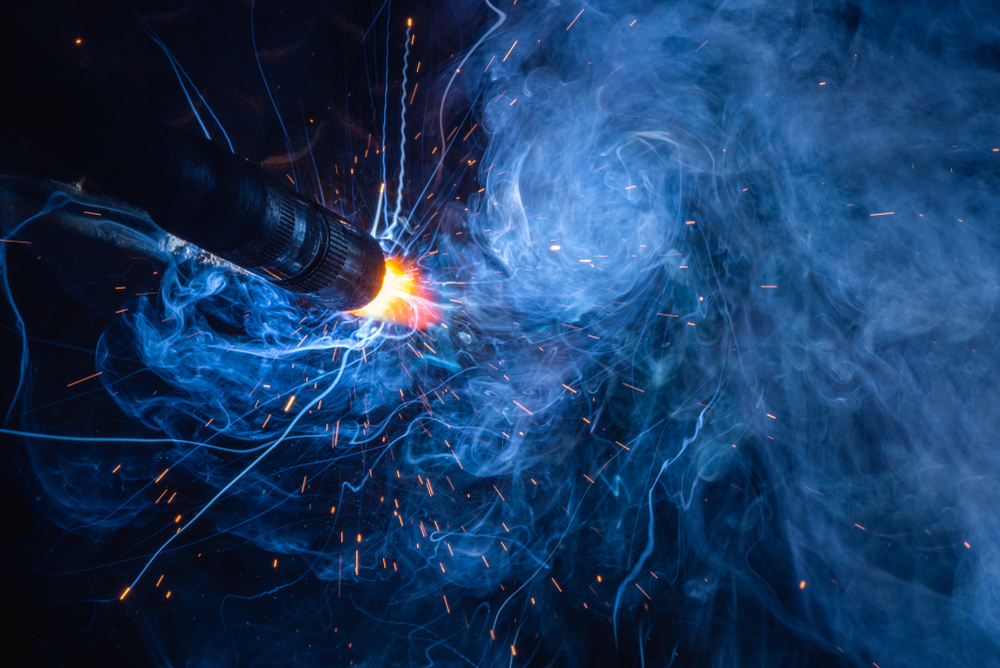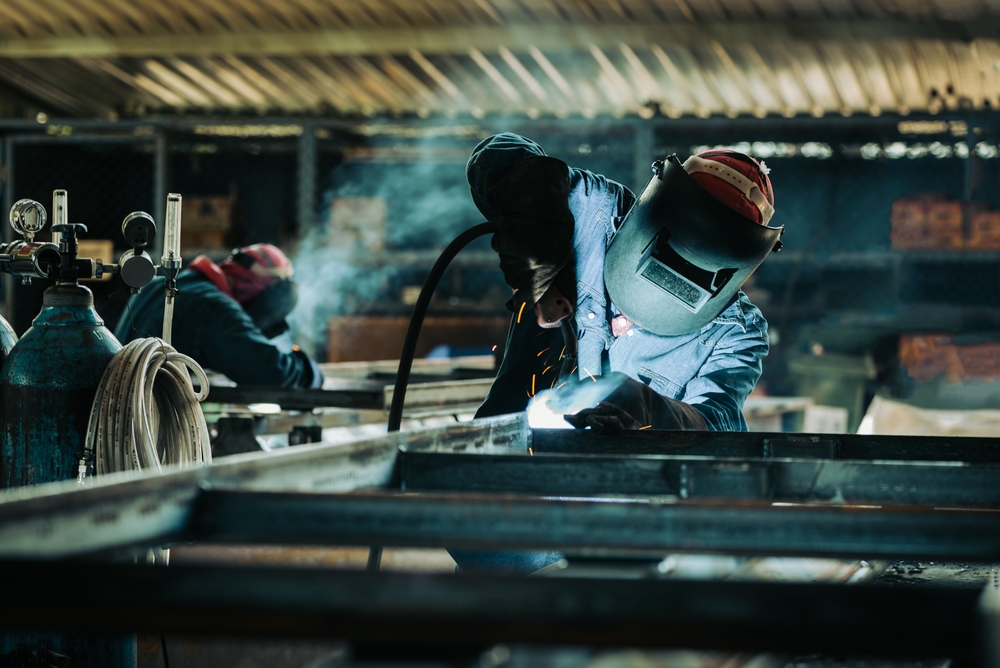A good industrial fabrication company will be able to offer a full range of welding processes so that the best process can be chosen for a given application. However, one of the most useful and frequently used welding processes is FCAW. FCAW has some outstanding advantages and capabilities; however, it also has disadvantages and limitations and isn’t suitable for all applications.
What Is FCAW?
FCAW is the term used to refer to Flux-Cored Arc Welding. It is a semi-automatic or automatic welding process that utilizes a continuously-fed tubular electrode that contains a flux. Thus, the electrode is “flux-cored.” The flux contains mineral compounds and powdered metals, which produce a protective slag over the welding bead. This, in turn, helps to protect the quality and finish of the weld.
FCAW is similar to MIG welding, GMAW, stick welding, or SMAW. However, because FCAW uses a continuously fed electrode, there is no need to make frequent restarts, which helps lower the chances of a defect and produces a more uniform weld. The continuous nature of the welding also allows for higher productivity. There are two main types of flux-cored welding:
No Shielding Gas—The flux-cored electrode used in FCAW generates its own protective gas to shield the weld. Thus, FCAW can often be performed without additional shielding gas without compromising weld quality. This eliminates the cost and setup associated with a separate shielding gas system. FCAW without shielding gas is particularly effective for thinner, flat-position metals. The lack of a shielding gas also allows this process to be effective in outdoor or windy environments that would dissipate a shielding gas.
With Shielding Gas – For welding on thicker, out-of-position metals, especially structural steel welding, FCAW may be used with a shielding gas for greater quality and consistency. This is often known as “duel shield” welding since both the shielding gas and the flux are used to shield the weld. This process is better used in a controlled environment, such as a fabrication shop where wind will not interfere with the shielding gas. The shielding gas is commonly carbon dioxide (CO2) or an argon-carbon dioxide mixture such as C-25, which contains 75% argon and 25% carbon dioxide.
Historical Background of FCAW
Flux-Cored Arc Welding (FCAW) was developed in the 1950s as an alternative to Manual Metal Arc (MMA) or stick welding. It was designed to overcome some of MMA’s limitations, such as the need for continuous electrode replacement. FCAW revolutionized welding with its continuous wire feed, making it more efficient and versatile, especially in outdoor and challenging welding environments.

Types of FCAW
FCAW-S (Self-Shielded FCAW)
Flux-Cored Arc Welding (FCAW) comes in two primary types, each suited to different welding environments and needs. The first type, Self-Shielded FCAW, is a robust option for outdoor work, especially where wind and weather are factors. This method doesn’t require an external shielding gas, as the flux core in the electrode generates its own protective atmosphere. It’s known for its portability and excellent penetration into the base metal, making it an ideal choice for onsite repairs and construction.
FCAW-G (Gas-Shielded FCAW or Dual Shield welding)
The second type, Gas-Shielded FCAW or Dual Shield welding, combines a flux-cored electrode with an external shielding gas, typically a mix of argon and carbon dioxide. This method was developed primarily for welding structural steels and is preferred for thicker materials and positions that are challenging to access. It produces consistent welds with fewer defects and allows for a higher production rate, making it a favorite in workshop settings.
Process Variables in FCAW
Understanding and controlling various process variables is essential to achieve optimal results in Flux-Cored Arc Welding (FCAW). These include:
- Wire Feed Speed: Dictates the rate at which the electrode is fed into the weld pool, impacting penetration and weld bead size.
- Arc Voltage: Affects the arc length and, consequently, the weld bead profile and penetration.
- Electrode Extension: The distance from the contact tip to the arc influences current density and heat input.
- Travel Speed: Determines the amount of filler metal deposited and the final weld bead’s appearance.
- Electrode Angles: The orientation of the electrode affects the direction of the heat and filler metal.
- Electrode Wire Type: Different types offer benefits, like improved strength or corrosion resistance.
- Shielding Gas Composition: In Gas-Shielded FCAW, this affects the weld pool’s stability and metal transfer characteristics.
- Polarity: FCAW typically uses reverse polarity (Electrode Positive) for gas-shielded wires and straight polarity (Electrode Negative) for self-shielded wires.
- Contact Tip to Work Distance (CTWD) impacts electrical resistance in the circuit and, therefore, the heat input into the weld.
Equipment Required for FCAW
For effective Flux-Cored Arc Welding, the right equipment is crucial. Essential FCAW equipment includes:
- Power Source: Provides the necessary voltage and amperage for maintaining the welding arc.
- Welding Gun: Air and water-cooled guns offer maneuverability and efficiency.
- Welding Cables: Copper cables connecting the welding gun to the power source.
- Wire Feeder: This drives the electrode wire through the gun. It is equipped with a rotor and gearbox for smooth feeding.
- Shielding Gas Equipment: For gas-shielded FCAW, this includes gas supply hoses, regulators, control valves, and supply hoses.

FCAW Electrodes
In FCAW, the choice of electrode is key. Unlike MIG welding’s solid wires, FCAW uses electrodes with a hollow center filled with flux. This flux protects the weld joint from atmospheric contamination and can also add beneficial elements to the weld metal. Selecting the right electrode wire is critical to achieving the desired weld quality and properties.
Suitable Metals for FCAW
FCAW is versatile and capable of welding a range of metals effectively. These include:
- Cast Iron: Suitable for repair and fabrication.
- Stainless Steel: Widely used in food processing equipment and chemical plants.
- Carbon Steel: Common in construction and structural applications.
- High-Nickel Alloys: For high-strength and corrosion-resistant applications.
- Low-Alloy Steels: Often used in high-strength components
Welding Methods and Techniques
FCAW is just one of many welding methods available. Some other popular methods include Gas Metal Arc Welding (GMAW), Submerged Arc Welding (SAW), and Tungsten Inert Gas (TIG) welding. Each method has its own unique advantages and applications. GMAW, for example, uses a welding machine that feeds a solid wire continuously, while SAW involves a welding arc submerged under a blanket of flux, protecting the molten metal from contamination. TIG welding uses a non-consumable tungsten electrode to produce the weld, offering high precision and clean welds, making it ideal for thinner materials and intricate work. FCAW is a robust welding method that utilizes an electric arc to melt the welding wire and the base metals, forming a strong joint. This method stands out due to its high deposition rates and the ability to weld thicker metals. Flux core arc welding is particularly effective for structural steel and heavy equipment repairs.
Equipment and Materials
In flux-cored welding, the choice of electrode wires and filler materials is crucial. The continuous filler metal electrode ensures a steady supply of material to the weld pool. The filler wire core contains flux, which helps achieve consistent mechanical properties in the final weld. Proper selection of welding wire and electrode wires contributes to the overall quality of the weld.
Consistency and Quality
Flux core welding provides consistent mechanical properties and high-quality welds with fewer defects. This consistency is essential for critical applications where the strength and integrity of the weld are paramount. Proper technique and equipment maintenance are key to achieving the best flux core arc welding results.
The Advantages of FCAW
Several excellent advantages to FCAW make it a very popular choice for welding. These include:
- Yields high quality, consistent welds with fewer defects
- A high deposition rate is the speed at which the filler metal is applied.
- Suitable for outdoor welding or shop welding.
- It can be used in all positions with the right filler metal.
- The welding arc has good visibility.
- More forgiving of rust, scale, and other metal contaminants.
- Provides excellent weld penetration.
- Allows for high welding productivity.
- Compared to other welding processes, it is relatively easy to learn.
Another welding process that offers unique advantages is Gas Metal Arc Welding Pulse (GMAW Pulse).
The Disadvantages of FCAW
However, despite FCAW’s many excellent advantages, there are also some disadvantages. These include:
- A high level of noxious fumes must be ventilated.
- Higher electrode wire cost compared to solid electrode wires.
- More costly equipment than many other welding processes.
- Less portable equipment than SMAW or GTAW.
- The slag covering the weld must be removed.
- Mechanical problems can lead to melted contact tips, irregular wire feed, or weld porosity.
- Not well-suited to all metal types.
For certain projects where FCAW might not be the best fit, other welding processes, such as Gas Tungsten Arc Welding (GTAW), could be a more suitable choice.
Industrial and Construction Applications of FCAW

Flux-Cored Arc Welding (FCAW) is a versatile and efficient welding process extensively used across various industries. It is known for its strong weld quality and consistency, essential in industrial and construction settings. Here are some of its critical applications:
- Construction: FCAW is widely used for joining heavy steel structures, making it a cornerstone in the construction industry. Its ability to produce strong welds quickly and efficiently is invaluable in constructing buildings and bridges.
- Heavy Equipment Repair: In the field of machinery and equipment repair, FCAW stands out for its efficiency. It’s ideal for repairing heavy equipment due to its excellent weld penetration and strength.
- Shipbuilding: The shipbuilding industry relies on FCAW for manufacturing and repairing ships. This process is particularly effective with thick materials, a common requirement in shipbuilding.
- Structural Steel Erection: FCAW’s reliability and strength make it a preferred method for structural steel erection. It plays a vital role in constructing robust and durable structures.
- Industrial Manufacturing: FCAW is excellent for welding structural steel, iron alloys, and nickel-based alloys commonly used in industrial manufacturing. Thanks to its excellent weld penetration, it simplifies joint design.
- High Productivity Projects: The high productivity rates achievable with FCAW make it suitable for projects under tight deadlines or requiring quick turnarounds.
- Contaminated Base Metals: FCAW can better overcome contamination than other welding processes, making it effective even when rust or mill scale is present on the base metals.
These diverse applications underscore the significance of FCAW in both heavy industrial manufacturing and construction sectors. Its ability to handle a variety of materials and conditions, coupled with its efficiency and strong weld quality, make FCAW a go-to method in these demanding fields.
STI Group is proud to offer our industrial fabrication clients a full range of welding processes, including FCAW. We will always strive to utilize the best welding process for a given project and rigorously test our welds to ensure that there are no defects. Whether the project involves FCAW or another welding process, our clients can count on STI Group for strong, dependable welds and superior fabrication.
FAQs
What Metals Can Be Welded With FCAW?
FCAW is versatile and can be used with various metals, primarily iron-based alloys. The metals that can be effectively welded using FCAW include:
Stainless Steel: FCAW is frequently used for welding stainless steel. It offers good penetration and weld quality. It can handle different types of stainless steel, including austenitic, ferritic, and duplex varieties.
Cast Iron: FCAW can weld cast iron, which requires careful handling due to its brittleness. Specific FCAW wires designed for cast iron are often used, containing nickel or nickel-based alloys to match mechanical properties and thermal expansion.
Carbon Steel: This includes both low-carbon (mild) steel and high-carbon steel. FCAW is suitable for structural fabrication, pipelines, shipbuilding, and general metal fabrication involving carbon steel.
Can FCAW Be Used To Weld Aluminum?
CAW is generally not used for welding aluminum. The flux-cored wires used in FCAW are designed for a flux core that generates its own shielding gas, which is incompatible with the requirements of aluminum welding. Aluminum welding requires a different type of shielding gas, typically pure argon or a helium-argon mix, to protect the weld pool from atmospheric contamination. Currently, there is no AWS (American Welding Society) specification for flux-cored wire for aluminum welding, indicating the limited availability of aluminum-specific flux-cored electrodes
Can Flux-Cored Arc Welding Produce Strong Welds?
Yes, FCAW can produce strong welds when executed correctly in suitable conditions. The strength of an FCAW weld depends on factors like welding technique, welding parameters, base metal properties, filler metal selection, and joint design. FCAW is known for its deep penetration and high deposition rates, contributing to strong welds. It can effectively join thick sections of material and produce welds with good fusion and mechanical properties
More Resources on FCAW
Flux-Cored Arc Welding (FCAW) – Linde Gas
Flux-Cored Arc Welding (FCAW): Definition, Purpose, and How It Works-Xometry

